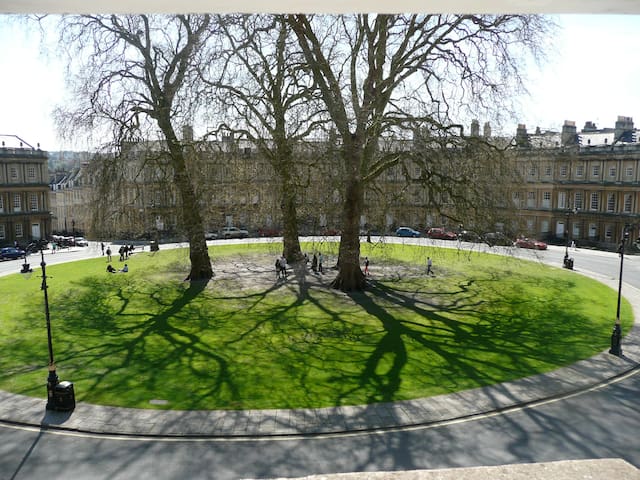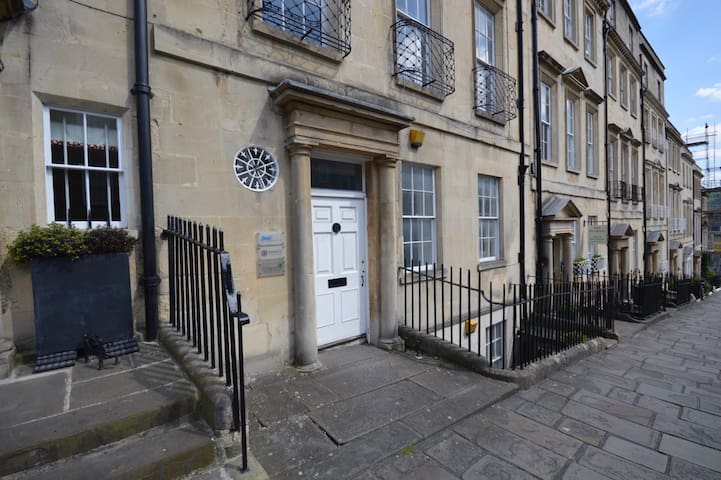Bath Sightseeing
The world heritage city of Bath is famed for its Roman remains and its Georgian architecture. The city that began life as a Roman spa built around its hot springs became one of King Alfred’s defenses against the Vikings.
As Bath’s hot spring grew, the need for the development resulted in the Georgian architecture you see today. John Wood the elder was the architect of vision who set the pattern for others to follow. He Planned Queen Square, the Parades and the Circus as speculative ventures.
The Royal Crescent is one of the world’s best-known landmarks. Built between 1767 and 1775 and designed by John Wood the younger, the crescent contains 30 houses one of which is Number 1, which is open to the public.
As the spacious streets of the Georgian upper town spread out around it, the ancient core of the city became congested. In 1789 the Bath Improvement Act gave the City Council powers to purchase, demolish and rebuild. Its target was the heart of the spa: the baths, Pump Room and their approaches, the architect was Robert Adam.
The entirely rural 600-acre estate of Bathwick was next for development owned by William Pulteney. The first part of the development was Pulteney Bridge one of only four bridges lined with shops in the world, the design inspired by similar bridges in Florence and Venice.
One of the world’s best landmarks. Number 1 is open to the public.
172 lokal ang nagrerekomenda
Royal Crescent
Royal CrescentOne of the world’s best landmarks. Number 1 is open to the public.
Bath Abbey is an active Christian church situated at the heart of the city.
165 lokal ang nagrerekomenda
Bath Abbey
Bath Abbey is an active Christian church situated at the heart of the city.
An exhibition and tearooms celebrating Jane’s Bath experience.
www.janeausten.co.uk
123 lokal ang nagrerekomenda
Sentro ng Jane Austen
40 Gay StAn exhibition and tearooms celebrating Jane’s Bath experience.
www.janeausten.co.uk
The Assembly Rooms were at the heart of fashionable Georgian society, the perfect venue for entertainment. The Fashion Museum is on the lower ground floor.
43 lokal ang nagrerekomenda
Mga Kuwartong Pulong
Bennett StreetThe Assembly Rooms were at the heart of fashionable Georgian society, the perfect venue for entertainment. The Fashion Museum is on the lower ground floor.
Britain’s only natural hot spring, the Roman’s built a magnificent temple and bathing complex that still flows with natural hot water. The Pump Room restaurant is open for breakfast, lunch and afternoon tea. www.romanbaths.co.uk
544 lokal ang nagrerekomenda
Ang Mga Roman Baths
Abbey ChurchyardBritain’s only natural hot spring, the Roman’s built a magnificent temple and bathing complex that still flows with natural hot water. The Pump Room restaurant is open for breakfast, lunch and afternoon tea. www.romanbaths.co.uk
The Circus
The CircusThe Circus is the masterpiece of John Wood the Elder.
Pulteney Bridge is one of only four bridges lined with shops in the world, the design inspired by similar bridges in Florence and Venice.
93 lokal ang nagrerekomenda
Pulteney Bridge
Bridge StreetPulteney Bridge is one of only four bridges lined with shops in the world, the design inspired by similar bridges in Florence and Venice.
An impressive collection of fine and decorative art. The museum with garden cafe is situated in lovely grounds at the end of the elegant Pulteney Street.
190 lokal ang nagrerekomenda
Ang Museo ng Holburne
Great Pulteney Street
An impressive collection of fine and decorative art. The museum with garden cafe is situated in lovely grounds at the end of the elegant Pulteney Street.
Neighbourhoods
The world heritage city of Bath is famed for its Roman remains and its Georgian architecture. The city that began life as a Roman spa built around its hot springs became one of King Alfred’s defenses against the Vikings.
As Bath’s hot spring grew, the need for the development resulted in the Georgian architecture you see today. John Wood the elder was the architect of vision who set the pattern for others to follow. He Planned Queen Square, the Parades and the Circus as speculative ventures.
The Royal Crescent is one of the world’s best-known landmarks. Built between 1767 and 1775 and designed by John Wood the younger, the crescent contains 30 houses one of which is Number 1, which is open to the public.
As the spacious streets of the Georgian upper town spread out around it, the ancient core of the city became congested. In 1789 the Bath Improvement Act gave the City Council powers to purchase, demolish and rebuild. Its target was the heart of the spa: the baths, Pump Room and their approaches, the architect was Robert Adam.
The entirely rural 600-acre estate of Bathwick was next for development owned by William Pulteney. The first part of the development was Pulteney Bridge one of only four bridges lined with shops in the world, the design inspired by similar bridges in Florence and Venice.
9 lokal ang nagrerekomenda
City Centre
The world heritage city of Bath is famed for its Roman remains and its Georgian architecture. The city that began life as a Roman spa built around its hot springs became one of King Alfred’s defenses against the Vikings.
As Bath’s hot spring grew, the need for the development resulted in the Georgian architecture you see today. John Wood the elder was the architect of vision who set the pattern for others to follow. He Planned Queen Square, the Parades and the Circus as speculative ventures.
The Royal Crescent is one of the world’s best-known landmarks. Built between 1767 and 1775 and designed by John Wood the younger, the crescent contains 30 houses one of which is Number 1, which is open to the public.
As the spacious streets of the Georgian upper town spread out around it, the ancient core of the city became congested. In 1789 the Bath Improvement Act gave the City Council powers to purchase, demolish and rebuild. Its target was the heart of the spa: the baths, Pump Room and their approaches, the architect was Robert Adam.
The entirely rural 600-acre estate of Bathwick was next for development owned by William Pulteney. The first part of the development was Pulteney Bridge one of only four bridges lined with shops in the world, the design inspired by similar bridges in Florence and Venice.
Food scene
This historic building is one of the oldest houses in Bath. An historic eating house where you can sample an original Bath Bun
58 lokal ang nagrerekomenda
Sally Lunn's Historic Eating House & Museum
4 N ParadeThis historic building is one of the oldest houses in Bath. An historic eating house where you can sample an original Bath Bun
The View - The apartment location
The apartment is centrally located towards the bottom of Lansdown Road OPPOSITE Bennett Street. Its location gives you easy access on foot to everything the glorious city of Bath has to offer
Bennett Street
Bennett StreetThe View is located on Lansdown Road OPPOSITE Bennett Street
Payo sa lungsod
Huwag palampasin
Bath Christmas Market
A Popular event for tourists and locals. Best to visit during the week, avoiding weekends as it gets very busy.
Paano makapaglibot
Walk or take the hop on/off open top city sightseeing bus
Bath city is quite small and easy to walk around with easy access to all attractions.
Paano makapaglibot
Bath Spa Train Station
Regular train service to Bristol and Bradford on Avon



